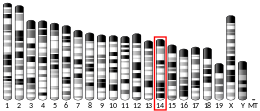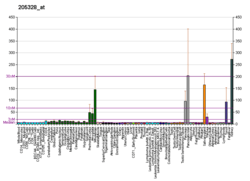CLDN10
Claudin-10 is a protein that in humans is encoded by the CLDN10 gene.[5][6] It belongs to the group of claudins.
This gene encodes a member of the claudin family. Claudins are integral membrane proteins and components of tight junction strands. Tight junction strands serve as a physical barrier to prevent solutes and water from passing freely through the paracellular space between epithelial or endothelial cell sheets. Two alternatively spliced transcript variants that encode different isoforms have been identified for this gene.[6]
References
- GRCh38: Ensembl release 89: ENSG00000134873 - Ensembl, May 2017
- GRCm38: Ensembl release 89: ENSMUSG00000022132 - Ensembl, May 2017
- "Human PubMed Reference:". National Center for Biotechnology Information, U.S. National Library of Medicine.
- "Mouse PubMed Reference:". National Center for Biotechnology Information, U.S. National Library of Medicine.
- Ip YC, Cheung ST, Lee YT, Ho JC, Fan ST (Nov 2007). "Inhibition of hepatocellular carcinoma invasion by suppression of claudin-10 in HLE cells". Mol Cancer Ther. 6 (11): 2858–67. doi:10.1158/1535-7163.MCT-07-0453. PMID 18025272.
- "Entrez Gene: CLDN10 claudin 10".
External links
- Human CLDN10 genome location and CLDN10 gene details page in the UCSC Genome Browser.
Further reading
- Kniesel U, Wolburg H (2000). "Tight junctions of the blood–brain barrier". Cell. Mol. Neurobiol. 20 (1): 57–76. doi:10.1023/A:1006995910836. PMID 10690502.
- Heiskala M, Peterson PA, Yang Y (2001). "The roles of claudin superfamily proteins in paracellular transport". Traffic. 2 (2): 93–8. doi:10.1034/j.1600-0854.2001.020203.x. PMID 11247307.
- Tsukita S, Furuse M, Itoh M (2001). "Multifunctional strands in tight junctions". Nat. Rev. Mol. Cell Biol. 2 (4): 285–93. doi:10.1038/35067088. PMID 11283726.
- Tsukita S, Furuse M (2003). "Claudin-based barrier in simple and stratified cellular sheets". Curr. Opin. Cell Biol. 14 (5): 531–6. doi:10.1016/S0955-0674(02)00362-9. PMID 12231346.
- González-Mariscal L, Betanzos A, Nava P, Jaramillo BE (2003). "Tight junction proteins". Prog. Biophys. Mol. Biol. 81 (1): 1–44. doi:10.1016/S0079-6107(02)00037-8. PMID 12475568.
- Kubota K, Furuse M, Sasaki H, et al. (2000). "Ca(2+)-independent cell-adhesion activity of claudins, a family of integral membrane proteins localized at tight junctions". Curr. Biol. 9 (18): 1035–8. doi:10.1016/S0960-9822(99)80452-7. PMID 10508613.
- Christian SL, McDonough J, Liu Cy CY, et al. (2002). "An evaluation of the assembly of an approximately 15-Mb region on human chromosome 13q32-q33 linked to bipolar disorder and schizophrenia". Genomics. 79 (5): 635–56. doi:10.1006/geno.2002.6765. PMID 11991713.
- Brandner JM, Kief S, Grund C, et al. (2003). "Organization and formation of the tight junction system in human epidermis and cultured keratinocytes" (PDF). Eur. J. Cell Biol. 81 (5): 253–63. doi:10.1078/0171-9335-00244. PMID 12067061.
- Strausberg RL, Feingold EA, Grouse LH, et al. (2003). "Generation and initial analysis of more than 15,000 full-length human and mouse cDNA sequences". Proc. Natl. Acad. Sci. U.S.A. 99 (26): 16899–903. doi:10.1073/pnas.242603899. PMC 139241. PMID 12477932.
- Ota T, Suzuki Y, Nishikawa T, et al. (2004). "Complete sequencing and characterization of 21,243 full-length human cDNAs". Nat. Genet. 36 (1): 40–5. doi:10.1038/ng1285. PMID 14702039.
- Gerhard DS, Wagner L, Feingold EA, et al. (2004). "The Status, Quality, and Expansion of the NIH Full-Length cDNA Project: The Mammalian Gene Collection (MGC)". Genome Res. 14 (10B): 2121–7. doi:10.1101/gr.2596504. PMC 528928. PMID 15489334.
- Cheung ST, Leung KL, Ip YC, et al. (2005). "Claudin-10 expression level is associated with recurrence of primary hepatocellular carcinoma". Clin. Cancer Res. 11 (2 Pt 1): 551–6. PMID 15701840.
- Liu F, Koval M, Ranganathan S, Fanayan S, Hancock WS, Lundberg EK, Beavis RC, Lane L, Duek P, McQuade L, Kelleher NL, Baker MS (2015). "A systems proteomics view of the endogenous human claudin protein family". J Proteome Res. 15 (2): 339–359. doi:10.1021/acs.jproteome.5b00769. PMC 4777318. PMID 26680015.
This article is issued from Wikipedia. The text is licensed under Creative Commons - Attribution - Sharealike. Additional terms may apply for the media files.




